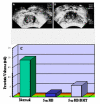Molecular Basis of Steroid Action in the Prostate
- PMID: 16971966
- PMCID: PMC1564164
- DOI: 10.1901/jaba.2005.1-27
Molecular Basis of Steroid Action in the Prostate
Figures






Similar articles
-
The mouse as a model to investigate sex steroid metabolism in the normal and pathological prostate.J Steroid Biochem Mol Biol. 2012 Sep;131(3-5):107-21. doi: 10.1016/j.jsbmb.2011.10.009. Epub 2011 Dec 1. J Steroid Biochem Mol Biol. 2012. PMID: 22146616 Review.
-
Steroid-involved transcriptional regulation of human genes encoding prostatic acid phosphatase, prostate-specific antigen, and prostate-specific glandular kallikrein.Endocrinology. 1997 Sep;138(9):3764-70. doi: 10.1210/endo.138.9.5413. Endocrinology. 1997. PMID: 9275063
-
Steroid receptors in prostate cancer tissues and cells: pathophysiology, problems in methodology, clinical value and controversial questions.Arch Esp Urol. 1994 Mar;47(2):189-201. Arch Esp Urol. 1994. PMID: 8002681 Review.
-
Androgen receptors and the molecular basis for the action of antiadrogens in the ventral prostate.J Reprod Fertil Suppl. 1976 Sep;(24 suppl):147-62. J Reprod Fertil Suppl. 1976. PMID: 794465 Review.
-
Targeting rapid action of sex steroid receptors in breast and prostate cancers.Front Biosci (Landmark Ed). 2011 Jun 1;16(6):2224-32. doi: 10.2741/3849. Front Biosci (Landmark Ed). 2011. PMID: 21622172 Review.
Cited by
-
DHT deteriorates the progression of monocrotaline-induced pulmonary arterial hypertension: effects of endogenous and exogenous androgen.Am J Transl Res. 2019 Sep 15;11(9):5752-5763. eCollection 2019. Am J Transl Res. 2019. PMID: 31632545 Free PMC article.
-
Trans-, cis-, and dihydro-resveratrol: a comparative study.Chem Cent J. 2011 Dec 20;5:88. doi: 10.1186/1752-153X-5-88. Chem Cent J. 2011. PMID: 22185600 Free PMC article.
-
Androgen stimulates endothelial cell proliferation via an androgen receptor/VEGF/cyclin A-mediated mechanism.Am J Physiol Heart Circ Physiol. 2011 Apr;300(4):H1210-21. doi: 10.1152/ajpheart.01210.2010. Epub 2011 Jan 21. Am J Physiol Heart Circ Physiol. 2011. PMID: 21257919 Free PMC article.
-
Role of androgens in cardiovascular pathology.Vasc Health Risk Manag. 2018 Oct 15;14:283-290. doi: 10.2147/VHRM.S173259. eCollection 2018. Vasc Health Risk Manag. 2018. PMID: 30410343 Free PMC article. Review.
-
Suppression of DHT-induced paracrine stimulation of endothelial cell growth by estrogens via prostate cancer cells.Prostate. 2013 Jul;73(10):1069-81. doi: 10.1002/pros.22654. Epub 2013 Feb 19. Prostate. 2013. PMID: 23423946 Free PMC article.
References
-
- Chang C, Kokontis J, Liao S. Molecular cloning of human and rat complementary DNA encoding androgen receptors. Science. 1988;240:324–326. - PubMed
-
- Lubahn DB, Joseph DR, Sullivan PM, Willard HF, French FS, Wilson EM. Cloning of human androgen receptor complementary DNA and localization to the X chromosome. Science. 1988;240:327–330. - PubMed
-
- Quigley CA, De Bellis A, Marschke KB, el-Awady MK, Wilson EM, French FS. Androgen receptor defects: historical, clinical, and molecular perspectives. Endocr Rev. 1995;16:271–321. - PubMed
-
- Heinlein CA, Chang C. Androgen receptor (AR) co-regulators: an overview. Endocr Rev. 2002;23:175–200. - PubMed
-
- La Spada AR, Wilson EM, Lubahn DB, Harding AE, Fischbeck KH. Androgen receptor gene mutations in X-linked spinal and bulbar muscular atrophy. Nature. 1991;352:77–79. - PubMed
Grants and funding
LinkOut - more resources
Full Text Sources
